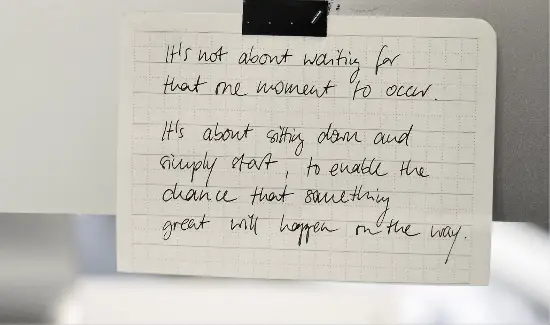“The Power of Positive Thinking” is a self-help book written by Dr. Norman Vincent Peale. It’s a timeless guide that encourages individuals to embrace positivity and optimism in their lives. Here’s a detailed summary using simple words:
Introduction:
The book begins by emphasizing the importance of maintaining a positive mindset in all aspects of life. Dr. Peale highlights that one’s thoughts have a significant impact on their experiences, and by cultivating a positive attitude, individuals can overcome challenges and achieve success.
Key Concepts
Believe in Yourself:
Believing in yourself means having confidence and trust in your own abilities. Dr. Peale emphasizes that when you believe in yourself, you acknowledge your strengths and talents. It’s like being your own cheerleader, knowing that you can handle challenges and achieve your goals.
Self-Confidence:
Believing in yourself starts with having confidence. This means knowing that you are capable and worthy. Dr. Peale suggests recognizing your achievements, even small ones, to boost your confidence.
Embracing Your Abilities:
Understanding and appreciating what you’re good at is a crucial part of self-belief. It’s about recognizing your unique skills and talents and being proud of them.
Positive Self-Talk:
Pay attention to the way you talk to yourself. Dr. Peale recommends using positive language in your thoughts and words. Instead of saying, “I can’t do this,” shift to “I can do this, and I will try my best.”
Setting Realistic Goals:
Believing in yourself involves setting achievable goals. Dr. Peale suggests breaking down big goals into smaller, manageable steps. Celebrate each accomplishment along the way, reinforcing your belief in your ability to succeed.
Learning from Setbacks:
Mistakes and setbacks are a natural part of life. Dr. Peale encourages viewing them as opportunities to learn and grow. Believing in yourself means bouncing back from failures with resilience and determination.
Surrounding Yourself with Positivity:
The people you spend time with can influence your self-belief. Dr. Peale recommends surrounding yourself with supportive and positive individuals who uplift and encourage you.
Visualizing Success:
Picture yourself succeeding in your mind. Dr. Peale introduces the concept of positive imaging—creating mental images of achieving your goals. This visualization technique reinforces your belief in your ability to turn your aspirations into reality.
Taking Action:
Belief in yourself is not just about thinking positively; it’s also about taking action. Dr. Peale suggests setting realistic plans and working towards your goals. Each step forward reinforces your confidence.

The Power of Positive Imaging:
Positive imaging is like creating a mental movie of good things happening in your mind. Dr. Peale teaches that by picturing success and happiness in your thoughts, you can actually bring those positive things into your life. It’s a way to use your imagination to make your dreams come true.
Imagining Success:
Positive imaging starts with imagining yourself succeeding. Picture yourself reaching your goals. Dr. Peale suggests creating clear and detailed mental images of what success looks and feels like for you.
Feeling the Success:
It’s not just about seeing success; it’s about feeling it too. Dr. Peale encourages you to experience the emotions connected to your positive images. If you can feel the joy and satisfaction in your mind, it helps attract those positive outcomes.
Repetition:
Positive imaging is most effective when done regularly. Dr. Peale recommends making it a habit. Repeat these positive images daily, especially during quiet times, to reinforce them in your mind.
Affirmations and Positive Thinking:
Positive imaging goes hand in hand with positive affirmations. Use positive words and phrases along with your mental images. This combination helps to reprogram your mind for positivity.
Overcoming Doubt:
Doubts and negative thoughts may come up. Dr. Peale advises dismissing them and refocusing on your positive images. Over time, this helps to replace doubts with confidence.
Applying Positive Imaging in Daily Life:
Positive imaging isn’t just for big goals; you can use it in everyday situations. Dr. Peale suggests visualizing success in various aspects of your life, such as relationships, work, or personal growth.
Staying Realistic:
While positive imaging is powerful, Dr. Peale emphasizes staying realistic. Your mental images should be achievable. This way, you build a sense of belief that what you’re picturing is actually possible.
Patience and Persistence:
Positive imaging takes time to show results. Dr. Peale advises being patient and persistent. Keep at it, and gradually you may see positive changes in your life.

Affirmations and Positive Thinking:
Affirmations and positive thinking involve using words and thoughts to create a more positive and constructive mindset. Dr. Peale encourages individuals to repeat positive statements to themselves regularly, fostering a mental environment that supports well-being and success.
Choosing Positive Words:
Affirmations are positive statements or phrases that you say to yourself. Dr. Peale suggests choosing words that inspire confidence, happiness, and success. For example, saying “I am capable and confident” or “I attract positivity” are affirmations.
Repetition:
The power of affirmations comes from repetition. Dr. Peale recommends saying these positive statements regularly. The more you repeat them, the more they become ingrained in your thinking.
Morning and Night Routine:
Dr. Peale suggests incorporating affirmations into your daily routine, especially in the morning and at night. Saying positive statements when you wake up and before you go to bed can set a positive tone for your day.
Belief in Affirmations:
To make affirmations work, you need to believe in what you’re saying. Dr. Peale emphasizes that having faith in positive statements enhances their effectiveness.

Positive Visualization:
Combine affirmations with positive visualization. Picture the affirmations coming true as you say them. Dr. Peale teaches that the combination of positive words and mental images can reinforce each other.
Applying Affirmations to Goals:
Tailor affirmations to your specific goals. If you have a goal in mind, create affirmations related to that goal. For instance, if your goal is to be more confident, repeat statements like “I am confident in my abilities.”
Overcoming Negative Thoughts:
Affirmations counteract negative thoughts. Dr. Peale advises using affirmations to challenge and replace negative thoughts. When you catch yourself thinking negatively, repeat a positive affirmation to shift your mindset.
Flexibility in Affirmations:
Be flexible with your affirmations. Dr. Peale suggests adjusting them based on your current needs and circumstances. This flexibility allows you to address different aspects of your life.
Creating a Positive Atmosphere:
Surround yourself with positivity. Dr. Peale recommends incorporating positive thinking into your daily life beyond affirmations. Cultivate an overall positive atmosphere by choosing optimistic thoughts.

Overcoming Worry and Stress:
Overcoming worry and stress involves adopting strategies to manage and reduce these negative feelings. Dr. Peale provides practical advice to help individuals cope with life’s challenges, promoting a calm and composed mindset.
Identifying the Source:
Recognize what is causing worry and stress. Dr. Peale suggests understanding the root of these feelings to address them effectively.
Breaking Problems into Steps:
Large problems can be overwhelming. Dr. Peale recommends breaking them into smaller, more manageable steps. This approach makes it easier to tackle challenges without feeling stressed.
Avoiding Overthinking:
Overthinking can intensify worry. Dr. Peale advises against dwelling excessively on problems. Instead, focus on potential solutions and positive outcomes.
Positive Affirmations:
Use positive affirmations to counteract negative thoughts. Dr. Peale suggests repeating positive statements to replace worry-inducing thoughts, promoting a more optimistic mindset.
Relaxation Techniques:
Incorporate relaxation techniques into your routine. Dr. Peale recommends practices such as deep breathing, meditation, or gentle exercises to alleviate stress.
Prioritizing and Organizing:
Prioritize tasks and organize your schedule. Dr. Peale suggests focusing on essential tasks first and creating a structured plan to prevent feeling overwhelmed.
Limiting Exposure to Stressors:
Identify and limit exposure to stressors when possible. Dr. Peale advises minimizing contact with situations or people that contribute to stress, creating a more peaceful environment.
Maintaining Perspective:
Dr. Peale emphasizes the importance of maintaining perspective. Remember that not all problems are equally significant. Keeping things in context can reduce the impact of stress.
Healthy Lifestyle Choices:
Adopting a healthy lifestyle can positively impact stress levels. Dr. Peale recommends maintaining a balanced diet, getting regular exercise, and ensuring sufficient sleep to support overall well-being.
Seeking Support:
Share your concerns with trusted friends or family. Dr. Peale suggests seeking support and talking about your worries. Sometimes, expressing feelings can provide relief.
Embracing a Positive Outlook:
Cultivate a positive mindset. Dr. Peale advises focusing on positive aspects of life and redirecting thoughts towards optimistic outcomes, reducing the influence of worry.
Accepting Imperfection:
Accept that no one is perfect, and mistakes are a part of life. Dr. Peale encourages individuals to learn from errors rather than dwelling on them, lessening the burden of worry.
Turning Failures into Opportunities:
Turning failures into opportunities is about adopting a positive and growth-oriented mindset when faced with setbacks. Dr. Peale encourages individuals to see failures not as the end but as stepping stones toward learning and improvement.
Accepting Failure as Part of Life:
Acknowledge that everyone faces failures. Dr. Peale suggests accepting failure as a natural part of life’s journey, rather than viewing it as a final outcome.
Learning from Mistakes:
See failures as opportunities to learn. Dr. Peale emphasizes the value of understanding what went wrong and using that knowledge to make better choices in the future.
Building Resilience:
Cultivate resilience in the face of failure. Dr. Peale recommends developing the ability to bounce back and persevere, viewing challenges as temporary obstacles.
Finding Hidden Opportunities:
Look for hidden opportunities within failures. Dr. Peale suggests that setbacks can often lead to new and unexpected paths, offering opportunities for growth and success.
Adjusting Strategies:
Failure is a signal to reassess strategies. Dr. Peale advises individuals to modify their approaches, learn from past mistakes, and adopt new and more effective methods.
Maintaining a Positive Outlook:
Keep a positive mindset despite failures. Dr. Peale suggests focusing on the lessons learned and the potential for improvement rather than dwelling on the negative aspects.
Turning Setbacks into Comebacks:
Dr. Peale encourages individuals to view setbacks as opportunities for comebacks. Use the experience of failure as fuel for a more determined and successful future.
Seeking Feedback:
Ask for feedback after a failure. Dr. Peale recommends seeking input from others to gain valuable perspectives and insights, facilitating personal and professional growth.
Avoiding Self-Blame:
Resist blaming yourself excessively. Dr. Peale advises against dwelling on self-blame and guilt, instead focusing on constructive actions to move forward.
Fostering a Growth Mindset:
Cultivate a growth mindset. Dr. Peale encourages individuals to believe in their capacity for improvement, emphasizing that abilities can be developed over time.
Seeing Failure as a Temporary Setback:
Understand that failure is not the end of the road. Dr. Peale suggests viewing it as a temporary setback and an opportunity to reassess and redirect one’s path.
Celebrating Progress:
Acknowledge and celebrate progress, no matter how small. Dr. Peale recommends recognizing personal growth and accomplishments on the journey to success.
The Impact of Faith:
The impact of faith, as explained by Dr. Peale, extends beyond religious beliefs to encompass a broader sense of inner strength, belief, and confidence. It involves having a deep conviction that can provide comfort, resilience, and the courage to face life’s challenges.
Inner Strength:
Faith is like an inner strength that comes from believing in something. Dr. Peale suggests that having faith provides a source of power that helps individuals endure difficulties with resilience.
Courage in Challenges:
Faith gives you the courage to face challenges. Dr. Peale emphasizes that a strong belief can act as a guiding force during tough times, instilling the confidence needed to navigate through adversity.
Comfort in Hard Times:
Faith offers comfort in difficult situations. Dr. Peale teaches that believing in something greater than oneself provides a sense of solace, especially when facing uncertainties or hardships.
Hope in Despair:
In times of despair, faith provides hope. Dr. Peale suggests that even when things seem bleak, having faith can be a beacon of hope that things will get better.
Resilience in Setbacks:
Faith contributes to resilience after setbacks. Dr. Peale encourages individuals to draw on their faith to bounce back from failures, viewing them as temporary setbacks rather than permanent defeats.
Belief in Possibilities:
Faith involves believing in possibilities. Dr. Peale teaches that having faith expands one’s perspective, enabling individuals to see potential opportunities even in challenging circumstances.
Positive Outlook:
Faith cultivates a positive outlook. Dr. Peale suggests that a strong belief can shape a positive mindset, influencing how individuals perceive and respond to the events in their lives.
Comfort in Uncertainty:
In uncertain times, faith provides comfort. Dr. Peale advises that having faith can bring a sense of security and peace, helping individuals navigate through situations that are beyond their control.
Guidance in Decision-Making:
Faith can guide decision-making. Dr. Peale teaches that a strong belief system can serve as a moral compass, helping individuals make choices aligned with their values and principles.
Connecting with Something Greater:
Faith is a connection to something greater than oneself. Dr. Peale suggests that this connection fosters a sense of purpose and meaning, contributing to a more fulfilling and balanced life.
Encouragement in Endeavors:
In pursuing endeavors, faith provides encouragement. Dr. Peale encourages individuals to draw on their faith to persevere and stay motivated in reaching their goals.
Support in Relationships:
Faith can strengthen relationships. Dr. Peale suggests that a shared belief system can be a foundation for support and understanding in personal and interpersonal connections.
Application of Faith in Daily Life:
The application of faith in daily life involves integrating one’s beliefs and convictions into everyday actions and decisions. Dr. Peale emphasizes that faith is not just a theoretical concept but a guiding force that can shape how individuals approach challenges, interact with others, and find meaning in their experiences.
Mindset in Challenges:
Apply faith in challenging situations. Dr. Peale suggests maintaining a positive mindset, drawing on the belief that challenges are opportunities for growth and learning.
Decision-Making Guidance:
Let faith guide your decision-making. Dr. Peale encourages individuals to align their choices with their beliefs, using faith as a moral compass in navigating life’s complexities.
Facing Uncertainty with Confidence:
Confront uncertainty with confidence. Dr. Peale teaches that faith provides a sense of assurance, helping individuals face the unknown with a belief that things will work out.
Resilience in Setbacks:
Apply faith to bounce back from setbacks. Dr. Peale advises using faith as a source of resilience, viewing failures as temporary and focusing on the potential for future success.
Maintaining Hope in Difficult Times:
Keep hope alive in difficult times. Dr. Peale suggests that faith offers a foundation of hope, even when circumstances seem challenging, providing the strength to persevere.
Supporting Others with Compassion:
Extend faith to support others. Dr. Peale encourages individuals to express compassion and understanding based on their faith, fostering a supportive and empathetic approach in relationships.
Finding Meaning in Everyday Experiences:
Seek meaning in everyday experiences. Dr. Peale teaches that faith adds depth and significance to daily activities, allowing individuals to find purpose and fulfillment in their actions.
Applying Faith to Goals and Aspirations:
Align faith with goals and aspirations. Dr. Peale advises individuals to integrate their beliefs into their pursuit of dreams, using faith to stay motivated and focused on achieving objectives.
Cultivating a Positive Outlook:
Foster a positive outlook through faith. Dr. Peale suggests that faith contributes to a positive mindset, influencing how individuals perceive and respond to the events and challenges they encounter.
Building Strong Relationships:
Use faith to strengthen relationships. Dr. Peale encourages individuals to apply their beliefs in interpersonal connections, fostering trust, understanding, and shared values.
Expressing Gratitude:
Express gratitude based on faith. Dr. Peale advises acknowledging the blessings in life and expressing gratitude, recognizing the positive aspects that faith brings to daily experiences.
Embracing a Sense of Purpose:
Infuse daily activities with a sense of purpose. Dr. Peale teaches that faith can provide a guiding purpose in one’s actions, contributing to a more meaningful and intentional life.
Conclusion: The Power of Positive Thinking
In conclusion, Dr. Peale’s book emphasizes the transformative impact of maintaining a positive outlook on life. The central message is that adopting a positive mindset has the power to shape the trajectory of one’s life. Here’s a breakdown of the key points:
Positive Outlook and Life Changes:
The book asserts that being positive fundamentally alters the course of life. By approaching challenges with optimism, individuals can influence the outcomes and experiences they encounter.
Dealing with Problems:
Dr. Peale’s advice provides practical tools for dealing with life’s problems. The book likely offers strategies for reframing challenges, finding solutions, and maintaining resilience in the face of adversity.
Happiness and Positivity:
The core idea is that following Dr. Peale’s guidance leads to increased happiness. By incorporating positive thinking into daily life, individuals can enhance their overall well-being and satisfaction.
In essence, the book underscores the profound connection between one’s mindset and life experiences. Dr. Peale’s teachings likely offer insights into fostering a positive mental attitude, providing readers with the tools to approach difficulties with resilience and to cultivate a happier and more fulfilling life.

